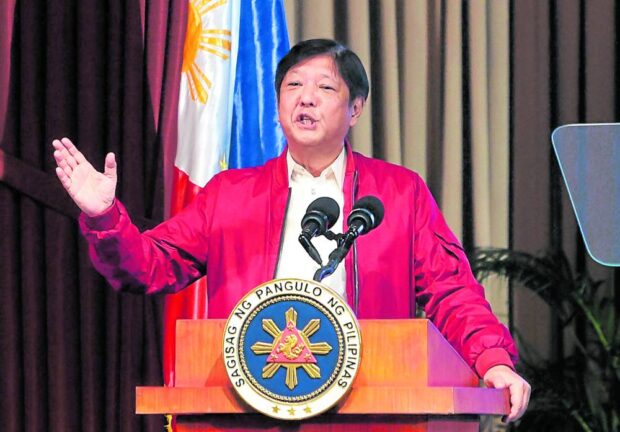Bongbong Marcos orders further review of gov’t posts for rightsizing

President Ferdinand Marcos Jr. INQUIRER file photo MARIANNE BERMUDEZ
MANILA, Philippines — President Ferdinand “Bongbong” Marcos Jr. has ordered a thorough assessment of the present set-up in the executive branch to determine redundant positions and functions.
Marcos gave the order after Tuesday’s sectoral meeting on the National Government Rightsizing Program (NGRP). At the meeting, he promised that government rightsizing aims not to fire employees but to improve government services and programs by training and retraining the current government workforce.
According to the Presidential Communications Office (PCO), the Presidential Legislative Liaison Office (PLLO) and the Department of Budget and Management (DBM) updated the President during the meeting on the status and salient features of the proposed National Government Rightsizing Bill.
“The President made an assurance during the meeting on Tuesday that government rightsizing is not aimed at terminating employees but to serve as a tool to upskill and reskill the current government workforce to improve state services and programs,” the PCO said.
The legislation, which the PCO said is seen to imply the devolution of local government functions, has already passed the third reading at the lower house of Congress.
Article continues after this advertisementThe President is given the authority to reduce the size and scope of executive branch agencies in Section 6 of House Bill 7240, also known as the National Government Rightsizing Act.
Article continues after this advertisementThese include:
- Pursuing functional shifts and modifications
- Implementing organizational actions based on the recommendation of the Committee on Rightsizing the Executive Branch (CREB)
- Undertaking other functional or organizational actions
- Developing and providing safety nets, and formulating an organizational development program to strengthen agency institutional capacity and improve employee productivity
Among the salient provisions of the bill are the mandatory coverage of all agencies of the executive branch, including departments, bureaus, offices, commissions, boards, councils, and all other entities attached to or under their administrative supervision, and government-owned or -controlled corporations (GOCCs) not covered under Republic Act No. 10149 or the GOCC Governance Act of 2011.
The NGRP excludes teaching and teaching-related positions in schools, medical and allied-medical items in hospitals and other medical facilities, military and uniformed personnel, and GOCCs and government financial institutions covered by the Governance Commission for GOCCs.
The legislature, judiciary, Office of the Ombudsman, constitutional commissions, and local government units (LGUs) may likewise right size their respective offices consistent with the principles and guidelines contained in the NGRP.
During his first State of the Nation Address (SONA), Marcos proposed the passage of the NGRP to enhance the government’s institutional capacity to perform its mandate and provide better services to the people while ensuring optimal and efficient use of resources.
Unlike previous attempts to reorganize the government, the President said that the NGRP would involve a full strategic review of all government agencies’ functions, operations, organization, systems, and processes.
It will also involve massive and transformational initiatives in the agencies concerned, such as mergers, consolidation, splitting, transfer, and even the abolition of some offices.
In response to what the President said in his State of the Nation Address, several bills were filed in Congress, such as House Bill No. 7240, which passed on its third and final reading by the House of Representatives on March 14.
Meanwhile, the three bills on the NGRP filed in the Senate remain pending at the committee level.
RELATED STORY:
Bill pushing for gov’t rightsizing gets House nod on third reading